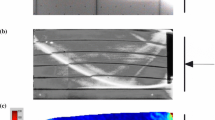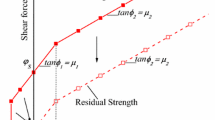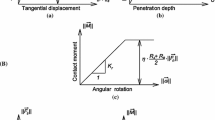Abstract
Numerical investigations of patterns of shear zones in granular bodies obtained during quasi-static plane strain compression tests were performed. The effect of a spatially correlated stochastic distribution of the initial void ratio and roughness of horizontal plates was analyzed. To describe a mechanical behavior of a cohesionless granular material during a monotonic deformation path in a plane strain compression test, a micro-polar hypoplastic constitutive model was used. FE calculations were carried out with both initially dense and initially loose cohesionless sand. A Latin hypercube method was applied to generate Gaussian truncated random fields of initial void ratio in a granular specimen. A weak correlation of the initial void ratio in both directions and its large standard deviation were assumed for all specimens. The horizontal boundaries were either ideally smooth or very rough. The FE results show similar patterns of shear zones as compared to experiments.











Similar content being viewed by others
References
Al Hattamleh O, Muhunthan B, Zbib HM (2005) Stress distribution in granular heaps using multi-slip formulation. Int J Numer Anal Methods Geomech 29:713–727
Alshibli KA, Sture S (2000) Shear band formation in plane strain experiments of sand. J Geotech Geoenviron Eng ASCE 126(6):495–503
Andrade JE, Baker JW, Ellison KC (2008) Random porosity fields and their influence on the stability of granular media. Int J Numer Anal Methods Geomech 32:1147–1172
Bauer E (1996) Calibration of a comprehensive hypoplastic model for granular materials. Soils Found 36(1):13–26
Bielewicz E, Górski J (2002) Shell with random geometric imperfections. Simulation-based approach. Int J Non-linear Mech 37(4–5):777–784
Brinkgreve R (1994) Geomaterial models and numerical analysis of softening. Dissertation, Delft University, pp 1–153
Chambon R (1989) A set of incrementally non-linear consistent constitutive equations for non viscous soils, solution for some consistency problems. CRAS 308(II):1571–1576
Chambon R, Moullet JC (2004) Uniqueness studies in boundary value problems involving some second gradient models. Comput Methods Appl Mech Eng 193:2771–2796
Chambon R, Caillerie D, Hassan El (1998) One dimensional localisation studied with a second grade model. Eur J Mech A/Solids 17(4):637–656
Darve F, Flavigny E, Megachou M (1995) Yield surfaces and principle of superposition revisited by incrementally non-linear constitutive relations. Int J Plast 11(8):927–948
de Borst R, Mühlhaus H-B (1992) Gradient dependent plasticity: formulation and algorithmic aspects. Int J Numer Methods Eng 35:521–539
Desrues J, Chambon R (1989) Shear band analysis for granular materials—the question of incremental linearity. Ing Archiv 59:187–196
Desrues J, Viggiani C (2004) Strain localization in sand: overview of the experiments in Grenoble using stereophotogrammetry. J Numer Anal Methods Geomech 28(4):279–321
Desrues J, Chambon R, Mokni M, Mazerolle F (1996) Void ratio evolution inside shear bands in triaxial sand specimens studied by computed tomography. Géotechnique 46(3):529–546
Górski J (2006) Non-linear models of structures with random geometric and material imperfections simulation-based approach, Gdansk University of Technology, p 68
Gudehus G (1996) A. comprehensive constitutive equation for granular materials. Soils Found 36(1):1–12
Gudehus G, Nübel K (2004) Evolution of shear bands in sand. Geotechnique, 113 54(3):187–201
Han C, Vardoulakis I (1991) Plane strain compression experiments on water saturated fine-grained sand. Geotechnique 41:49–78
Harris WW, Viggiani G, Mooney MA, Finno RJ (1995) Use of stereophotogrammetry to analyze the development of shear bands in sand. Geotech Test J 18(4):405–420
Herle I, Gudehus G (1999) Determination of parameters of a hypoplastic constitutive model from properties of grain assemblies. Mech Cohes Frict Mater 4(5):461–486
Herle I, Kolymbas D (2004) Hypoplasticity for soils with low friction angles. Comput Geotech 31:365–373
Knabe W, Przewłócki J, Różyński G (1998) Spatial averages for linear elements for two-parameter random field. Probab Eng Mech 13(3):147–167
Kolymbas D (1977) A rate-dependent constitutive equation for soils. Mech Res Commun 6:367–372
Kolymbas D (1987) A novel constitutive law for soils. In: Proceedings of second international conference on constitutive laws for engineering materials, vol 1. Elsevier, Amsterdam, pp 319–326
Lade PV (1977) Elasto-plastic stress–strain theory for cohesionless soil with curved yield surfaces. Int J Solid Struct 13:1019–1035
Lade PV (2002) Instability, shear banding and failure in granular materials. Int Solids Struct 39:3337–3357
Leśniewska D, Mróz Z (2003) Shear bands in soil deformation processes. In: Labuz J, Drescher A (eds) Bifurcations and Instabilities in Geomechanics. Swets and Zeitlinger, pp 109–119
Maier T (2002) Numerische Modellierung der Entfestigung im Rahmen der Hypoplastizität. Ph.D. thesis, University of Dortmund
Mandel J (1966) Conditions de stabilite et postulat de Drucker. Proceedings IUTAM Symposium Rheology and Soil Mechanics. Springer, Berlin, pp 58–68
Masin D (2005) A hypoplastic constitutive model for clays. Int J Numer Anal Methods Geomech 29:311–336
Mühlhaus H-B (1989) Application of Cosserat theory in numerical solutions of limit load problems. Ing Arch 59:124–137
Mühlhaus H-B (1990) Continuum models for layered and blocky rock. In: Hudson JA, Fairhurst Ch (eds) Comprehensive rock engineering, vol 2. Pergamon Press, New York, pp 209–231
Niemunis A (2003) Extended hypoplastic models for soils. Habilitation monography, Gdansk University of Technology
Niemunis A, Herle I (1997) Hypoplastic model for cohesionless soils with elastic strain range. Mech Cohes Frict Mater 2:279–299
Nübel K, Huang W (2004) A study of localized deformation pattern in granular media. Comput Methods Appl Mech Eng 193:2719–2743
Oda M (1993) Micro-fabric and couple stress in shear bands of granular materials. In: Thornton C (ed) Powders and grains. Balkema, Rotterdam, pp 161–167
Oda M, Kazama H (1998) Microstructure of shear bands and its relation to the mechanisms of dilatancy and failure of dense granular soils. Geotechnique 48:465–481
Ord A, Hobbs B, Regenauer-Lieb K (2007) Shear band emergence in granular materials—a numerical study. Int J Numer Anal Methods Geomech 31:373–393
Pasternak E, Mühlhaus H-B (2001) Cosserat continuum modelling of granulate materials. In: Valliappan S, Khalili N (eds) Computational mechanics—new frontiers for new millennium. Elsevier, Amsterdam, pp 1189–1194
Pena AA, García-Rojo R, Herrmann HJ (2007) Influence of particle shape on sheared dense granular media. Granul Matter 3–4:279–292
Pestana JM, Whittle AJ (1999) Formulation of a unified constitutive model for clays and sands. Int J Numer Anal Methods Geomech 23:1215–1243
Rechenmacher AL (2006) Grain-scale processes governing shear band initiation and evolution in sands. J Mech Phys Solids 54:22–45
Regueiro RA, Borja RI (2001) Plane strain finite element analysis of pressure sensitive plasticity with strong discontinuity. Int J Solids Struct 38(21):3647–3672
Rudnicki JW, Rice JR (1975) Conditions of the localization of deformation in pressure-sensitive dilatant materials. J Mech Phys Solids 23:371–394
Schäfer H (1962) Versuch einer Elastizitätstheorie des zweidimensionalen ebenen Cosserat-Kontinuums. Miszellaneen der Angewandten Mechanik, Festschrift Tolmien. Akademie, Berlin
Shahinpoor M (1980) Statistical mechanical considerations on the random packing of granular materials. Powder Technol 25:163–176
Siefert Y, Al-Holo A, Chambon (2009) Loss of uniqueness of solutions of the borehole problem modeled with enhanced media. Int J Solids Struct. doi:10.1016/j.ijsolstr.2009.04.014
Sluys L (1992) Wave propagation, localisation and dispersion in softening solids. Ph.D. thesis, Delft University of Technology
Tatsuoka F, Nakamura S, Huang CC, Tani K (1990) Strength anisotropy and shear band direction in plane strain test of sand. Soils Found 30(1):35–54
Tatsuoka F, Okahara M, Tanaka T, Tani K, Morimoto T, Siddiquee MS (1991) Progressive failure and particle size effect in bearing capacity of footing on sand. Proc ASCE Geotech Eng Congress 27(2):788–802
Tatsuoka F, Siddiquee MS, Yoshida T, Park CS, Kamegai Y, Goto T, Kohata SY (1994) Testing methods and results of element tests and testing conditions of plane strain model bearing capacity tests using air-dried dense Silver Buzzard Sand. Internal Report of University of Tokyo, pp 1–129
Tejchman J (1989) Scherzonenbildung und Verspannungseffekte in Granulaten unter Berücksichtigung von Korndrehungen. Publication series of the Institute of Soil and Rock Mechanics, University Karlsruhe, p 117
Tejchman J (1997) Shear localization and autogeneous dynamic effects in granular bodies, vol 140. Publication series of the Institute for Rock and Soil Mechanics, Karlsruhe University, pp 1–353
Tejchman J (2004) Influence of a characteristic length on shear zone formation in hypoplasticity with different enhancements. Comput Geotech 31(8):595–611
Tejchman J (2008) FE modeling of shear localization in granular bodies with micro-polar hypoplasticity. In: Wu W, Borja R (eds) Springer series in geomechanics and geoengineering. Springer, Berlin
Tejchman J, Bauer E (1996) Numerical simulation of shear band formation with a polar hypoplastic model. Comput Geotech 19(3):221–244
Tejchman J, Górski J (2008) Computations of size effects in granular bodies within micro-polar hypoplasticity during plane strain compression. Int J Solids Struct 45(6):1546–1569
Tejchman J, Górski J (2008) Deterministic and statistical size effect during shearing of granular layer within a micro-polar hypoplasticity. Int J Numer Anal Methods Geomech 32(1):81–107
Tejchman J, Górski J (2009) Modeling of bearing capacity of footings on sand within stochastic micro-polar hypoplasticity. J Numer Anal Methods Geomech (accepted)
Tejchman J, Gudehus G (2001) Shearing of a narrow granular strip with polar quantities. J Numer Anal Methods Geomech 25:1–18
Tejchman J, Niemunis A (2006) FE-studies on shear localization in an anisotropic micro-polar hypoplastic granular material. Granul Matter 8(3–4):205–220
Tejchman J, Wu W (1993) Numerical study on shear band patterning in a Cosserat continuum. Acta Mech 99:61–74
Tejchman J, Wu W (1995) Experimental and numerical study of sand–steel interfaces. Int J Numer Anal Methods Geomech 19(8):513–537
Tejchman J, Wu W (2007) Modeling of textural anisotropy in granular bodies within stochastic micro-polar hypoplasticity. Int J Non-Linear Mech 42:882–894
Tejchman J, Wu W (2009) Non-coaxiality and stress-dilatancy rule in granular materials: FE-investigation within micro-polar hypoplasticity. Int J Numer Anal Methods Geomech 33(1):117–142
Tejchman J, Wu W (2009) FE-investigations of shear localization in granular bodies under high shear rate. Granul Matter 11(2):115–128
Tejchman J, Herle I, Wehr J (1999) FE-studies on the influence of initial density, pressure level and mean grain diameter on shear localisation. Int J Numer Anal Methods Geomech 23(15):2045–2074
Tejchman J, Bauer E, Wu W (2007) Effect of texturial anisotropy on shear localization in sand during plane strain compression. Acta Mech 1–4:23–51
Uesugi M, Kishida H, Tsubakihara Y (1988) Behaviour of sand particles in sand–steel friction. Soils Found 28(1):107–118
Vanmarcke E-H (1983) Random fields: analysis and synthesis. MIT Press, Cambridge
Vardoulakis I (1980) Shear band inclination and shear modulus in biaxial tests. Int J Num Anal Methods Geomech 4:103–119
Vardoulakis I, Goldschneider M, Gudehus G (1995) Formation of shear bands in sand bodies as a bifurcation problem. Int J Numer Anal Methods Geomech 2:99–128
Vermeer P (1982) A five-constant model unifying well-established concepts. In: Gudehus G, Darve F, Vardoulakis I (eds) Proceedings of international workshop on constitutive relations for soils, Balkema, pp 175–197
von Wolffersdorff P (1996) A hypoplastic relation for granular materials with a predefined limit state surface. Mech Cohes Frict Mater 1:251–271
Walukiewicz H, Bielewicz E, Górski J (1997) Simulation of nonhomogeneous random fields for structural applications. Comput Struct 64(1–4):491–498
Wang C (1970) A new representation theorem for isotropic functions. J Ration Mech Anal 36:166–223
Weifner T, Kolymbas D (2007) A hypoplastic model for clay and sand. Acta Geotech 2:103–112
Wu W, Bauer E (1993) A hypoplastic model for barotropy and pyknotropy of granular soils. In: Kolymbas D (ed) Modern approach to plasticity. Elsevier, Amsterdam, pp 225–245
Yoshida T, Tatsuoka F, Siddiquee MS (1994) Shear banding in sands observed in plane strain compression. In: Chambon R, Desrues J, Vardoulakis I (eds) Localisation and bifurcation theory for soils and rocks. Balkema, Rotterdam, pp 165–181
Author information
Authors and Affiliations
Corresponding author
Rights and permissions
About this article
Cite this article
Tejchman, J., Górski, J. Finite element study of patterns of shear zones in granular bodies during plane strain compression. Acta Geotech. 5, 95–112 (2010). https://doi.org/10.1007/s11440-009-0103-6
Received:
Accepted:
Published:
Issue Date:
DOI: https://doi.org/10.1007/s11440-009-0103-6




